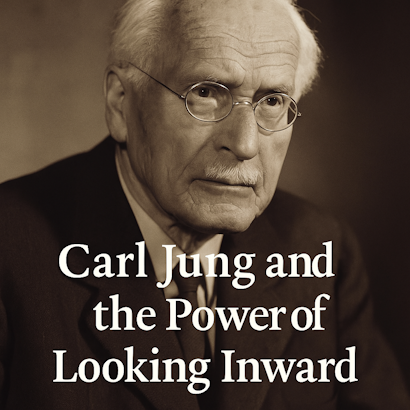
There is a quiet promise behind the word “introspection.” In an age where self-improvement is often reduced to productivity hacks and superficial optimisations, the invitation to truly look inside carries more weight than ever. Carl Jung understood this. He didn’t speak of introspection as a fleeting check-in or a daily affirmation. Instead, he called it individuation — a deep and often lifelong process of becoming whole. To look inside, in Jung’s sense, was to awaken to the vast terrain of the psyche and gradually integrate its fragmented pieces into something unified, coherent, and alive.
Jung believed that true growth comes not from achieving outward goals, but from facing the unconscious directly. He described the psyche as layered: on the surface, the ego and the verbal mind operate through thoughts and self-narratives. Beneath that lies the silent mind — a threshold space where the thinking subsides and the inner landscape begins to shift. Beyond this is the mind beyond thought, where the self dissolves and contact with the archetypal Self becomes possible. It is an inward descent. And in that descent, something is encountered that many recognise as a numinous presence: the deep, primordial archetype of wholeness itself.
To reach this level is not merely to know oneself in the conventional sense. It is to experience what Jung called psychic wholeness — a powerful integration of the conscious and unconscious mind. And this integration brings with it a kind of inner power, a quiet stability and resonance that cannot be faked. It is what many seekers sense as the goal of their spiritual or psychological journey, though they may not have words for it.
But Jung also issued warnings. To awaken the deeper layers of mind is to loosen the barriers that normally gate sensory input, emotion, and archetypal energies. The unconscious is not passive. It has autonomy. When the threshold is crossed without preparation or grounding, the unconscious may not trickle in gently. It can flood, overwhelming the ego with dreams, visions, emotions, or even existential disorientation. Jung observed that many individuals who begin this process feel destabilised, because they have opened the sensory gating of the higher mind without the structural support needed to hold what pours in.
Yet it is precisely this encounter that begins the process of individuation. Through witnessing, enduring, and integrating the contents of the unconscious — shadow, anima/animus, archetypes of transformation — one begins to shape a new self. Not an ego reinforced by affirmations, but a psyche structured around something real, something ancient.
Modern readers may recognise this in other forms: deep meditation, insight states, or moments of ego dissolution that reveal a greater coherence. Jung’s work affirms that such experiences are not illusions. They are contact with the Self, and they are possible. But they require commitment, discernment, and often silence.
To look inside is not simply to awaken. It is to be remembered. And to remember is to reassemble what was once whole. Psychic wholeness is not a reward for effort. It is the natural architecture of the mind, waiting to be seen. Jung did not promise that the journey would be easy. But he showed that it was real, and that the path begins with a single act: turning inward, and remaining there long enough to see what emerges.
As Jung himself said:
“Until you make the unconscious conscious, it will direct your life and you will call it fate.”
“Knowing your own darkness is the best method for dealing with the darknesses of other people.”
“The privilege of a lifetime is to become who you truly are.”
“Your visions will become clear only when you can look into your own heart. Who looks outside, dreams; who looks inside, awakes.”
These words don’t just validate the process — they complete it.
Discovering the Extended Brain-Mind and its powers is introspection.

